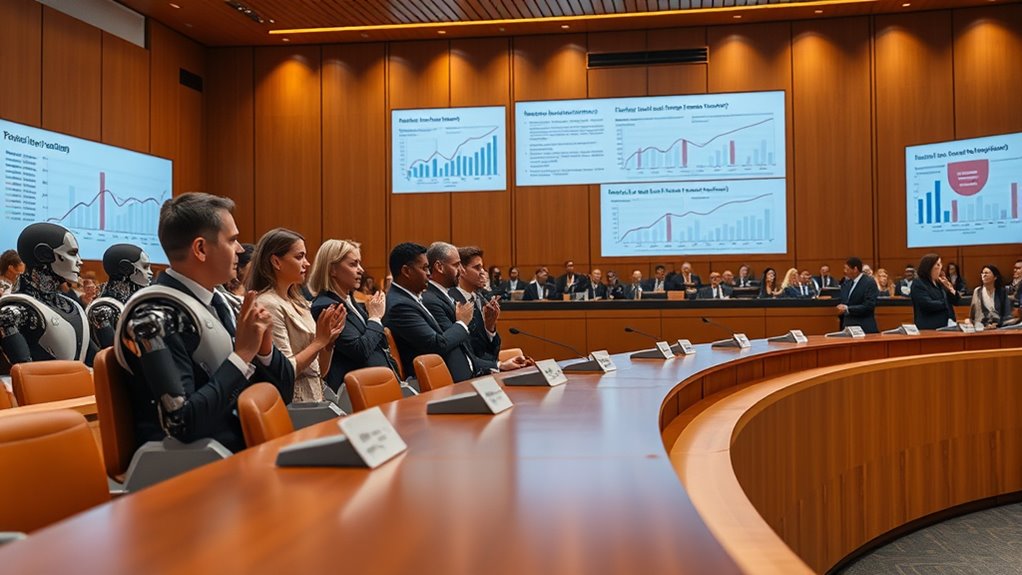Policy measures like robot taxes and stronger labor laws can slow automation by making it less attractive for companies to replace human workers, while also protecting employment and income stability. However, evidence shows these policies have limited impact on delaying automation trends. Striking the right balance is key—by combining targeted taxes with worker protections, you can foster innovation without risking widespread displacement. To understand how these strategies can work together, keep exploring the details behind these approaches.
Key Takeaways
- Robot taxes may modestly deter automation but often have limited impact due to low rates and enforcement challenges.
- Strengthening labor laws can help mitigate job displacement and improve worker protections amid automation.
- Combining targeted policies, like robot taxes and labor reforms, can better balance innovation with social equity.
- Gradual policy implementation allows businesses to adapt without significantly hindering technological progress.
- Effective policy integration requires aligning incentives to promote innovation while safeguarding workers and society.
The Rationale Behind Robot Taxes and Their Potential Impact

The primary rationale for implementing robot taxes is to address the economic and social challenges posed by automation, particularly job displacement and declining tax revenues. As robots replace human workers, governments face reduced income from payroll taxes and increased inequality. By taxing robots, you can create a financial disincentive for firms to automate excessively, encouraging them to retain human staff. Additionally, robot taxes aim to generate revenue that can be reinvested into social programs or workforce retraining. Supporters believe this approach can balance the benefits of automation with societal needs, preventing economic disparity from widening. Moreover, the contrast ratio in projectors demonstrates how visual clarity varies, just as policy impacts economic clarity. However, critics argue that such taxes might hinder innovation and slow technological progress, emphasizing the importance of carefully designing policies to avoid adverse effects on economic growth.
Examining the Effectiveness of Robot Taxes in Shaping Automation Trends

Does taxing robots effectively influence automation trends? Evidence suggests that the impact is limited. While robot taxes aim to slow automation by increasing costs for firms, studies show they often don’t markedly reduce investment in robotics. Instead, they may shift company strategies or delay adoption slightly, but overall automation continues. The ideal tax rates proposed—around 1% to 3.7%—are too low to act as a strong deterrent. Additionally, countries like South Korea reduced incentives for robot deployment, but automation still progressed. Implementing these taxes also faces practical challenges, such as defining what constitutes a robot and enforcing tax rules. A lack of comprehensive policy approaches further diminishes their potential effectiveness. Ultimately, robot taxes alone seem insufficient to meaningfully shape the broader automation trends. They may serve as part of a larger policy package but aren’t a decisive tool on their own.
How Labor Laws Can Mitigate Automation’s Displacement Effects

As automation continues to reshape workplaces, strengthening labor laws emerges as a practical way to reduce job displacement and income inequality. You can advocate for policies that protect workers, such as improved severance packages, portable benefits, and job transition programs. Implementing wage standards and promoting collective bargaining give employees leverage and stability amid automation shifts. By setting limits on mandatory layoffs and requiring companies to offer retraining, labor laws can encourage firms to retain human workers longer. You also influence how automation impacts income distribution, ensuring that workers benefit from productivity gains rather than losing out. Strengthening these laws creates a safety net, making the workforce more adaptable and resilient to technological change, ultimately balancing innovation with social stability. Additionally, emphasizing the importance of bedroom design principles can foster a more comfortable and productive environment for workers adapting to new roles.
Balancing Economic Efficiency and Equity in Policy Design

Balancing economic efficiency and equity in policy design requires carefully weighing the benefits of automation against its social costs. You need to contemplate how automation boosts productivity and growth but can also widen income gaps and displace workers. Effective policies promote innovation while ensuring fair distribution of gains. For example, implementing targeted taxes or social safety nets can help address inequality without stifling progress. You should also evaluate the impact of policies on investment incentives, as overly restrictive measures might slow technological advancement. Striking this balance involves continuous assessment of economic data and social outcomes. Your goal is to foster a system that encourages technological progress while maintaining fairness, ensuring that the benefits of automation are broadly shared and its disruptions minimized. Incorporating a methodical approach to policy evaluation can further enhance the effectiveness of these measures.
Strategies for Integrating Policy Measures to Manage Automation

Integrating policy measures to manage automation requires a coordinated approach that aligns incentives across different sectors. To effectively do this, you should consider three key strategies:
- Gradual Implementation: Phase in robot taxes and regulations to allow businesses to adapt without disruption.
- Reforming Tax Systems: Adjust tax policies to reduce biases favoring capital, encouraging investments in human labor and innovation.
- Combining Policies: Pair robot taxes with labor law reforms, such as stronger worker protections, to balance automation’s benefits and risks. Additionally, understanding the astrological factors associated with attractiveness may influence societal perceptions of technological change.
Frequently Asked Questions
How Do Robot Taxes Vary Across Different Countries and Industries?
You’ll notice that robot taxes differ widely across countries and industries. For example, South Korea reduced incentives for deploying robots, while the EU considered but didn’t enact a tax. Industries like manufacturing face more pressure to tax robots to fund social programs, but tech-heavy sectors often resist such policies. These variations depend on each country’s economic goals, labor market needs, and political climate, shaping how and where robot taxes are applied.
What Are the Long-Term Economic Effects of Implementing Robot Taxes?
Implementing robot taxes could lead to decreased investment in automation, slowing technological progress over time. You might see reduced productivity growth and innovation, which can hinder economic expansion. However, if well-designed, these taxes could also promote a more equitable distribution of wealth and preserve jobs. Ultimately, the long-term effects depend on balancing the tax policies with incentives for innovation, ensuring sustainable growth while addressing societal concerns.
Can Robot Taxes Unintentionally Hinder Technological Innovation?
Yes, robot taxes can unintentionally hinder technological innovation. If you set high or complex taxes, you might discourage firms from investing in new automation technologies, fearing increased costs or regulatory hurdles. This can slow down progress and reduce the benefits automation could bring. To avoid this, you should consider gradual implementation and focus on policies that support innovation, rather than overly taxing or restricting the development of new technologies.
How Feasible Is It to Accurately Define and Measure Robots for Taxation Purposes?
Pinning down what counts as a robot for taxation is like catching a shadow—challenging and elusive. You’ll need clear, precise definitions that distinguish robots from software or other automation tools. Measuring their impact involves tracking automation levels, investment, and functionality. While tricky, establishing standardized criteria is essential to guarantee fair, effective taxes. Without it, you risk bureaucratic chaos and unintended loopholes, making enforcement a game of whack-a-mole.
What Role Do International Agreements Play in Regulating Robot Taxation?
International agreements play a vital role in regulating robot taxation by establishing common standards and reducing loopholes. You need these treaties to prevent tax evasion, promote fair competition, and guarantee consistent policies across borders. Without cooperation, countries might implement conflicting rules, encouraging firms to relocate or avoid taxes. By working together, you can create effective frameworks that manage automation’s global impact while fostering innovation and economic stability.
Conclusion
Ultimately, policies like robot taxes aim to slow automation’s march, balancing economic growth with social stability. While they can protect jobs, they might also hinder innovation and efficiency. You must weigh the desire to preserve employment against the risk of stagnation. Striking this balance isn’t easy—it’s a careful dance between fostering progress and safeguarding fairness. In this tension, your decisions shape whether automation becomes a tool for prosperity or a source of inequality.









